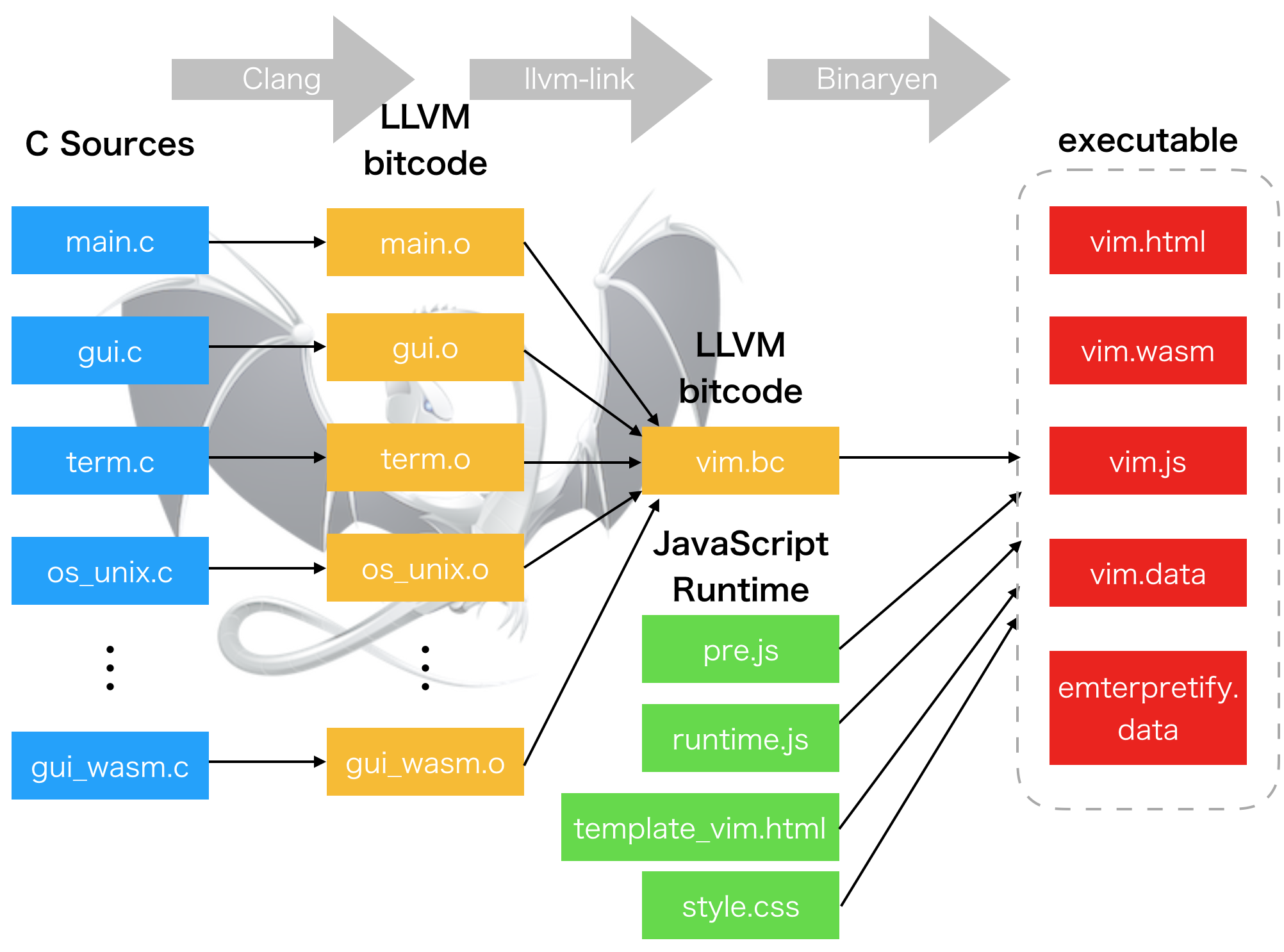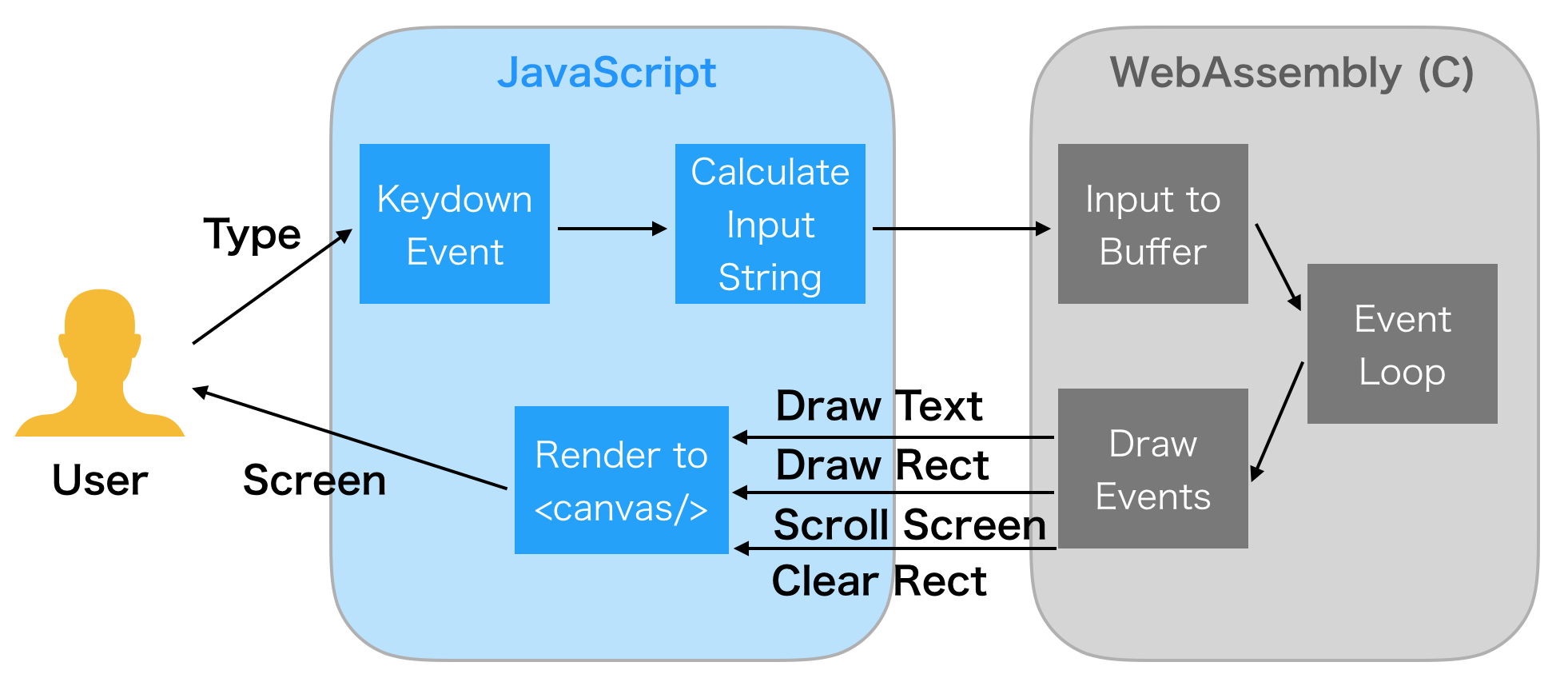This project is an experimental fork of Vim editor by @rhysd to compile it into WebAssembly using emscripten and binaryen.
- NOTICES
- Please access from a desktop browser (Chrome/Firefox/Safari/Edge). Safari seems the best on macOS.
- Please avoid mobile networks. Your browser will fetch some large files (up to 2.5MB).
- vim.wasm takes key inputs from DOM
keydownevent. Please disable your browser extensions which affect key inputs (incognito mode would be the best). - This project is very early phase of experiment. Currently only tiny features are supported. More features will be implemented (please see TODO section). And you may notice soon on trying it... it's buggy :)
- If inputting something does not change anything, please try to click somewhere in the page. Vim may have lost the focus.
The goal of this project is running Vim editor on browser by compiling Vim C sources into WebAssembly.
WebAssembly frontend for Vim is implemented as a new GUI frontend. C sources are
compiled to each LLVM bitcode files and then they are linked to one bitcode file
vim.bc by emcc. emcc finally compiles the vim.bc into vim.wasm binary
using binaryen and generates HTML/JavaScript runtime.
The difference I faced at first was the lack of terminal library such as ncurses.
I modified configure script to ignore the terminal library check. It's OK since
GUI frontend for Wasm is always used instead of CUI frontend. I needed many
workarounds to pass configure checks.
emscripten provides Unix-like environment. So os_unix.c can support Wasm. However,
some features are not supported by emscripten. I added many #ifdef FEAT_GUI_WASM
guards to disable features which cannot be supported by Wasm (i.e. fork (2)
support, PTY support, signal handlers are stubbed, ...etc).
I created gui_wasm.c heavily referencing gui_mac.c and gui_w32.c. Event loop
(gui_mch_update() and gui_mch_wait_for_chars()) is simply implemented with
sleep(). And almost all UI rendering events arer passed to JavaScript layer
by calling JavaScript functions from C thanks to emscripten.
C sources are compiled (with many optimizations) into LLVM bitcode with Clang
which is integrated to emscripten. Then all bitcode files (.o) are linked to
one bitcode file vim.bc with llvm-link linker (also integrated to emscripten).
Finally I created JavaScript runtime to draw the rendering events sent from C.
It is created as wasm/runtime.js using emscripten API.
It draws Vim screen to <canvas/> element with rendering events such as
'draw text', 'scroll screen', 'set foreground color', 'clear rect', ...etc.
emcc (emscripten's C compiler) compiles the vim.bc into vim.wasm, vim.js
and vim.html with preloaded Vim runtime files (i.e. colorscheme) using binaryen.
Runtime files are put on a virtual file system provided by emscripten on a browser.
Now hosting vim.html with a web server and accessing to it with browser opens
Vim. It works.
User interaction is very simple. You input something with keyboard. Browser takes
it as KeyboardEvent on keydown event and JavaScript runtime sends the input
to Wasm thanks to emscripten's JS to C API. Sent input is added to a buffer in C
layer. It affects the editor's state.
An editor core implemented in C calculates rendering events and sends it to
JavaScript layer thanks to emscripten's C to JS API. JavaScript runtime receives
rendering events and draws them to <canvas/> element in the web page.
Finally you can see the rendered results in the page.
Please make sure that Emscripten and binaryen (I'm using 1.38.6) are installed.
If you use macOS, they can be installed with brew install emscripten binaryen.
You can use build.sh script to hack this project. Just after cloning this
repository, simply run ./build.sh and it builds vim.wasm in wasm/ directory.
It takes time and CPU power a lot.
Finally host the wasm/ directly on localhost with web server such as
python -m http.server 1234. Accessing to localhost:1234/vim.html will start
Vim with debug build. Note that it's much slower than release build since many
debug features are enabled.
Please note that this repository's wasm branch is frequently rebased on the
latest vim/vim master branch. If you want to hack this project, please ensure
to create your own branch and merge wasm branch into your branch by git merge.
- WebAssembly nor JavaScript does not provide
sleep(). By default, emscripten compilessleep()into a busy loop. So vim.wasm is using Emterpreter which enablesemscripten_sleep(). But this feature is not so stable and makes built binaries larger and compilation longer. - JavaScript to C does not fully work with Emterpreter. For example, calling
some C APIs breaks Emterpreter stack. This also means that calling C functions
from JavaScript passing a
stringparameter does not work.
Development is managed in GitHub Projects.
- 'small' (or larger) features support (currently only 'tiny' features are supported)
- Async event loop (to disable Emterpreter)
- Mouse support
- Persistent
.vimrc - Packaging vim.wasm as npm package or ES Modules as Web Component
- Save files to local on
:write
This project was heavily inspired by impressive project vim.js by Lu Wang.
All additional files in this repository are licensed under the same license as
Vim (VIM LICENSE). Please see :help license for more detail.
Original README is following.
Vim is a greatly improved version of the good old UNIX editor Vi. Many new
features have been added: multi-level undo, syntax highlighting, command line
history, on-line help, spell checking, filename completion, block operations,
script language, etc. There is also a Graphical User Interface (GUI)
available. Still, Vi compatibility is maintained, those who have Vi "in the
fingers" will feel at home. See runtime/doc/vi_diff.txt for differences with
Vi.
This editor is very useful for editing programs and other plain text files. All commands are given with normal keyboard characters, so those who can type with ten fingers can work very fast. Additionally, function keys can be mapped to commands by the user, and the mouse can be used.
Vim runs under MS-Windows (NT, 2000, XP, Vista, 7, 8, 10), Macintosh, VMS and almost all flavours of UNIX. Porting to other systems should not be very difficult. Older versions of Vim run on MS-DOS, MS-Windows 95/98/Me, Amiga DOS, Atari MiNT, BeOS, RISC OS and OS/2. These are no longer maintained.
You can often use your favorite package manager to install Vim. On Mac and Linux a small version of Vim is pre-installed, you still need to install Vim if you want more features.
There are separate distributions for Unix, PC, Amiga and some other systems.
This README.md file comes with the runtime archive. It includes the
documentation, syntax files and other files that are used at runtime. To run
Vim you must get either one of the binary archives or a source archive.
Which one you need depends on the system you want to run it on and whether you
want or must compile it yourself. Check http://www.vim.org/download.php for
an overview of currently available distributions.
Some popular places to get the latest Vim:
- Check out the git repository from github.
- Get the source code as an archive.
- Get a Windows executable from the vim-win32-installer repository.
If you obtained a binary distribution you don't need to compile Vim. If you
obtained a source distribution, all the stuff for compiling Vim is in the
src directory. See src/INSTALL for instructions.
See one of these files for system-specific instructions. Either in the READMEdir directory (in the repository) or the top directory (if you unpack an archive):
README_ami.txt Amiga
README_unix.txt Unix
README_dos.txt MS-DOS and MS-Windows
README_mac.txt Macintosh
README_vms.txt VMS
There are other README_*.txt files, depending on the distribution you used.
The Vim tutor is a one hour training course for beginners. Often it can be
started as vimtutor. See :help tutor for more information.
The best is to use :help in Vim. If you don't have an executable yet, read
runtime/doc/help.txt. It contains pointers to the other documentation
files. The User Manual reads like a book and is recommended to learn to use
Vim. See :help user-manual.
Vim is Charityware. You can use and copy it as much as you like, but you are
encouraged to make a donation to help orphans in Uganda. Please read the file
runtime/doc/uganda.txt for details (do :help uganda inside Vim).
Summary of the license: There are no restrictions on using or distributing an unmodified copy of Vim. Parts of Vim may also be distributed, but the license text must always be included. For modified versions a few restrictions apply. The license is GPL compatible, you may compile Vim with GPL libraries and distribute it.
Fixing bugs and adding new features takes a lot of time and effort. To show your appreciation for the work and motivate Bram and others to continue working on Vim please send a donation.
Since Bram is back to a paid job the money will now be used to help children
in Uganda. See runtime/doc/uganda.txt. But at the same time donations
increase Bram's motivation to keep working on Vim!
For the most recent information about sponsoring look on the Vim web site: http://www.vim.org/sponsor/
If you would like to help making Vim better, see the CONTRIBUTING.md file.
The latest news about Vim can be found on the Vim home page: http://www.vim.org/
If you have problems, have a look at the Vim documentation or tips: http://www.vim.org/docs.php http://vim.wikia.com/wiki/Vim_Tips_Wiki
If you still have problems or any other questions, use one of the mailing lists to discuss them with Vim users and developers: http://www.vim.org/maillist.php
If nothing else works, report bugs directly: Bram Moolenaar Bram@vim.org
Send any other comments, patches, flowers and suggestions to: Bram Moolenaar Bram@vim.org
This is README.md for version 8.1 of Vim: Vi IMproved.



